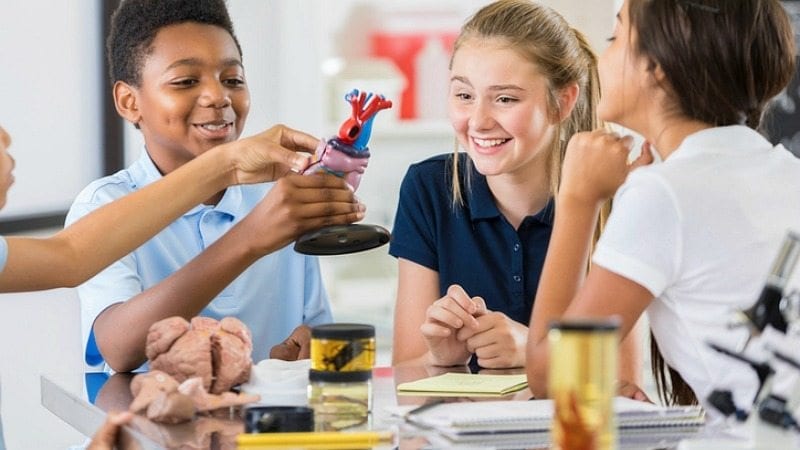We live in a digital age where STEM touches nearly every career in some way. To prepare our students, schools put a strong focus on STEM curricula that builds students’ skills in math and science and teaches them how to use various forms of technology. But what about soft skills?
Embracing the 4Cs
Employers are clamoring for well-qualified workers who not only have solid academic and technical skills but are also innovative problem solvers who can fill the jobs of the future. Cheryl Oldham, senior vice president of education policy at the U.S. Chamber of Commerce Foundation, says businesses value employees who are entrepreneurial, can work on a team, and are lifelong learners.

Schools are responding by embracing the 4Cs (creativity, critical thinking, communication, and collaboration) into their STEM curriculums.
Doubling Back to Creativity and Innovation
In Mt. Pleasant, Tennessee, principal Ryan Jackson is overseeing a “microcosm of innovation” on a public school campus for 1,200 PreK–14 students. Here, kids are building tiny houses, designing splash pads for the city, and doing engineering work for NASA.
“I think you are seeing education at a threshold where we are literally about to take this giant leap into this 21st-century-learning atmosphere … where we double down on creativity and innovation,” says Jackson. “The experiential, project-based learning has certainly gotten kids to understand it’s about more than rote memorization.

Rethinking Traditional “Sit-and-Get” Learning
Communication and collaboration skills are essential for everyone in the workplace. “If someone has an amazing idea, they have to sell that idea to other stakeholders to get buy in, and it’s important that they can tell the story,” says Gerard Ohen, director of global talent acquisition for Verizon. “Being able to effectively collaborate, being eager to learn, having the foundational ability to communicate and willingness to take risks are all important for students coming out of school.”
To create spaces where students are encouraged to communicate and collaborate, Thomas Jefferson High School for Science and Technology in Alexandria, Virginia, was recently renovated to bring about a collegiate feel. “Open commons areas and eclectic furnishings invite students to learn anytime anywhere,” says Ann Boniatatibus, principal of the highly ranked STEM school. “Classrooms have collapsible walls for team teaching, and desks have modular designs to facilitate group work.”

Schools need to rethink traditional “sit-and-get” learning to better prepare kids, says Tina Garrett, STEM coordinator at Garland Independent School District in Texas. “STEM is messy. STEM is loud. STEM is chaotic. But it’s so exciting and engaging to see,” she says. “It’s about doing. Students are creating, researching, tapping into digital assets to truly build their understanding.”
Enhancing Curriculum With Real-World Resources
“It’s critical [that] proper technology resources [and] immersive hands-on curriculum be provided so students can be prepared to thrive in this tech-dependent economy,” says Ohen.
To improve a school’s STEM offerings and boost student learning, districts are turning to high-quality resources for their STEM curriculum. Discovery Education’s STEM Connect is an innovative resource for grades K–8 that empowers educators to create engaging STEM lessons. It includes flexible, modular units that incorporate real-world challenges, hands-on activities, and links to STEM career options.
“Cooked-up data and invented problems are not going to cut it for today’s kids,” says Camsie McAdams, director of STEM curriculum for Discovery Education. “We need to put authentic, challenging problems that are truly engaging in front of students.” One way Discovery Education does this is by using content frameworks from the National Academy of Engineering’s Grand Challenges and the United Nations’ Sustainable Development Goals, which focus on solving global challenges, such as food security and making solar energy more economical.
Approaching STEM Not Just as a Subject—But as a Mindset
Fostering a love of STEM helps students become adept at solving all kinds of problems and developing critical thinking skills. “It’s important that we approach STEM not just as a subject but as a mindset,” says McAdams. When lessons are designed with various entry points and challenges, students from all backgrounds and abilities can become engaged. “The beauty of STEM is that there are often multiple solutions. Creating open-ended activities and accepting many pathways to solving problems speaks to this idea that we have diverse learners in our classrooms,” says McAdams.

At Jefferson High School, teachers design creative lessons that are project-based with applied STEM. For instance, a student interested in musical composition can write codes for suggested rhythms. Another student interested in election polling can develop an algorithm that predicts political party preferences, according to Boniatatibus.
Creating Career Connections
The more students realize the relevance of their STEM education, the more motivated they often become. Jefferson students are exposed to career paths through a strong mentor network and internships at nearby businesses and research facilities. “These experiences occur in authentic settings under the tutelage of industry experts, which in turn prepares students for college and careers,” says Boniatatibus.
Administrators can find these workplace learning opportunities for students by forming partnerships with local industry. “Reach out to your business leaders and chambers to forge a relationship,” advises Oldham, of the U.S. Chamber. Those connections can help educators align curriculum with the skills employers need and infuse the talent pipeline with students who are prepared to be successful in the workplace and beyond.

